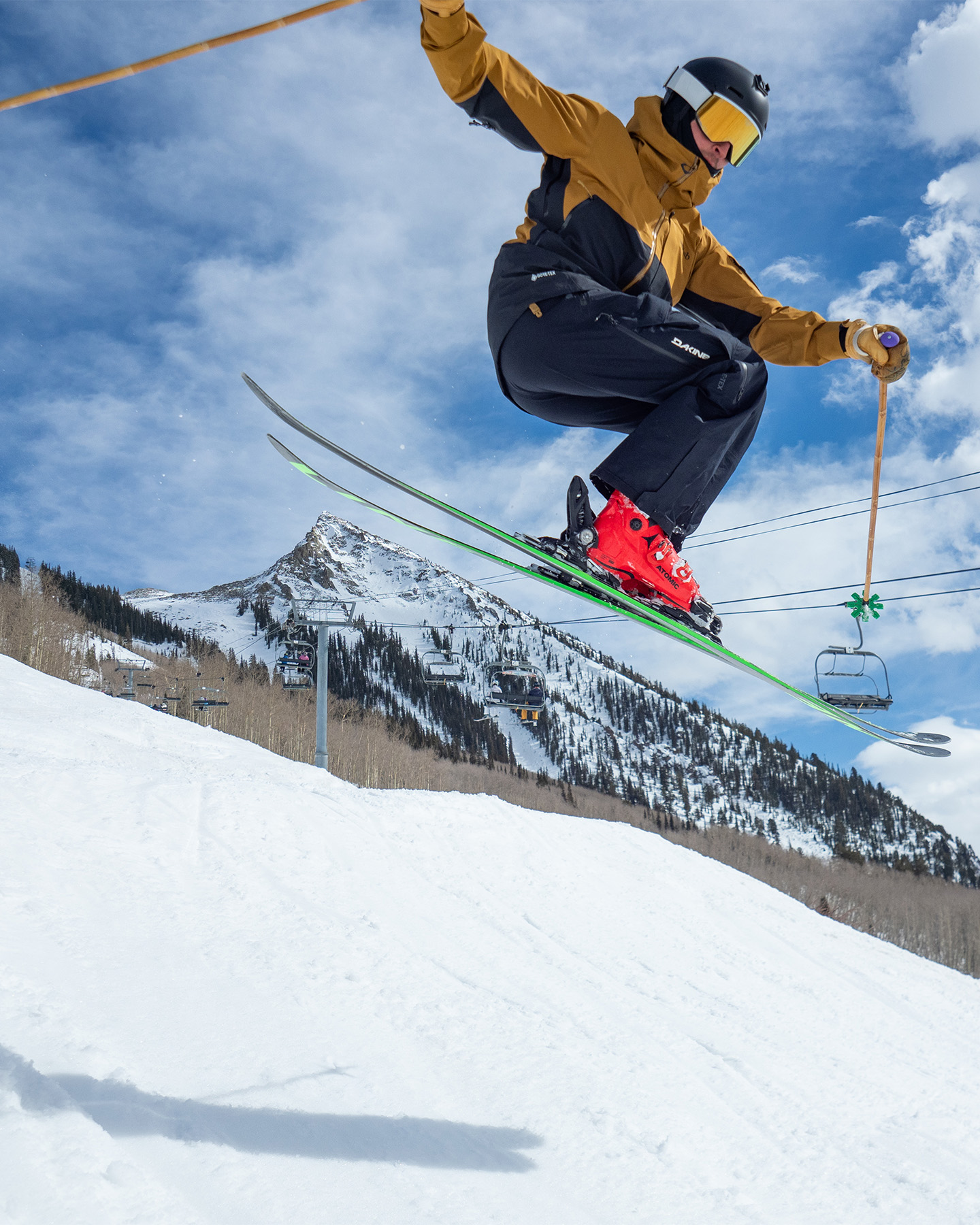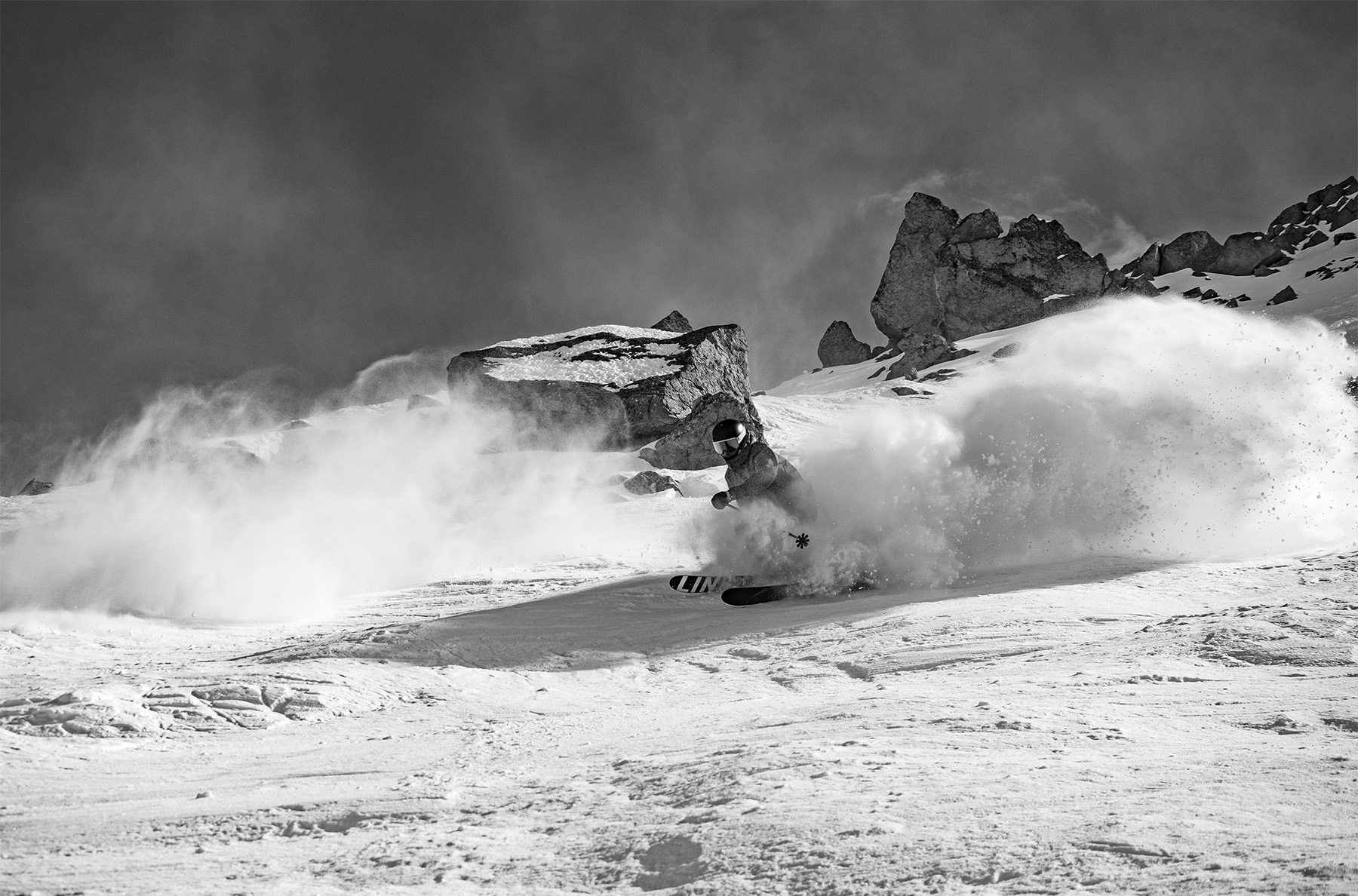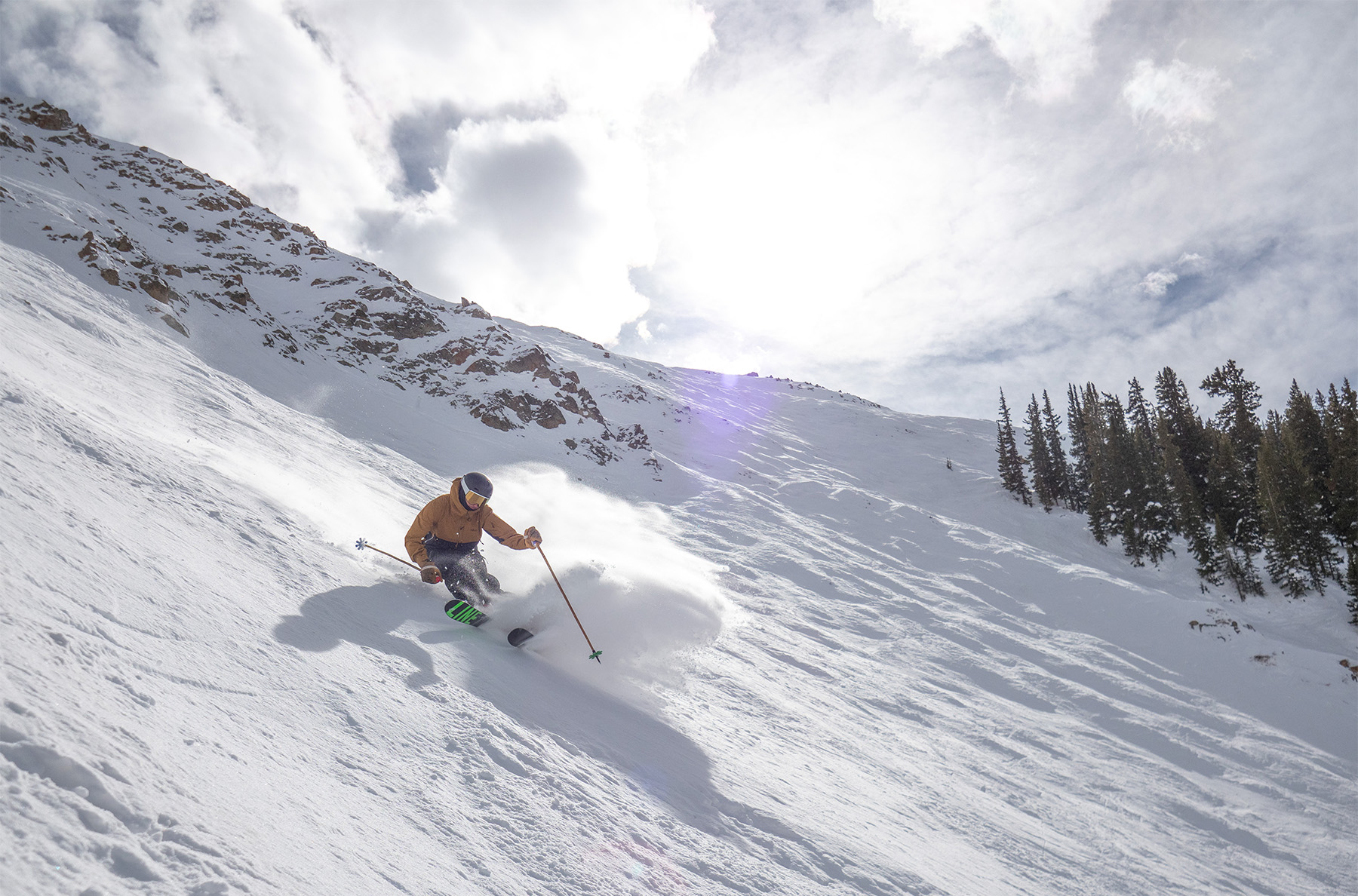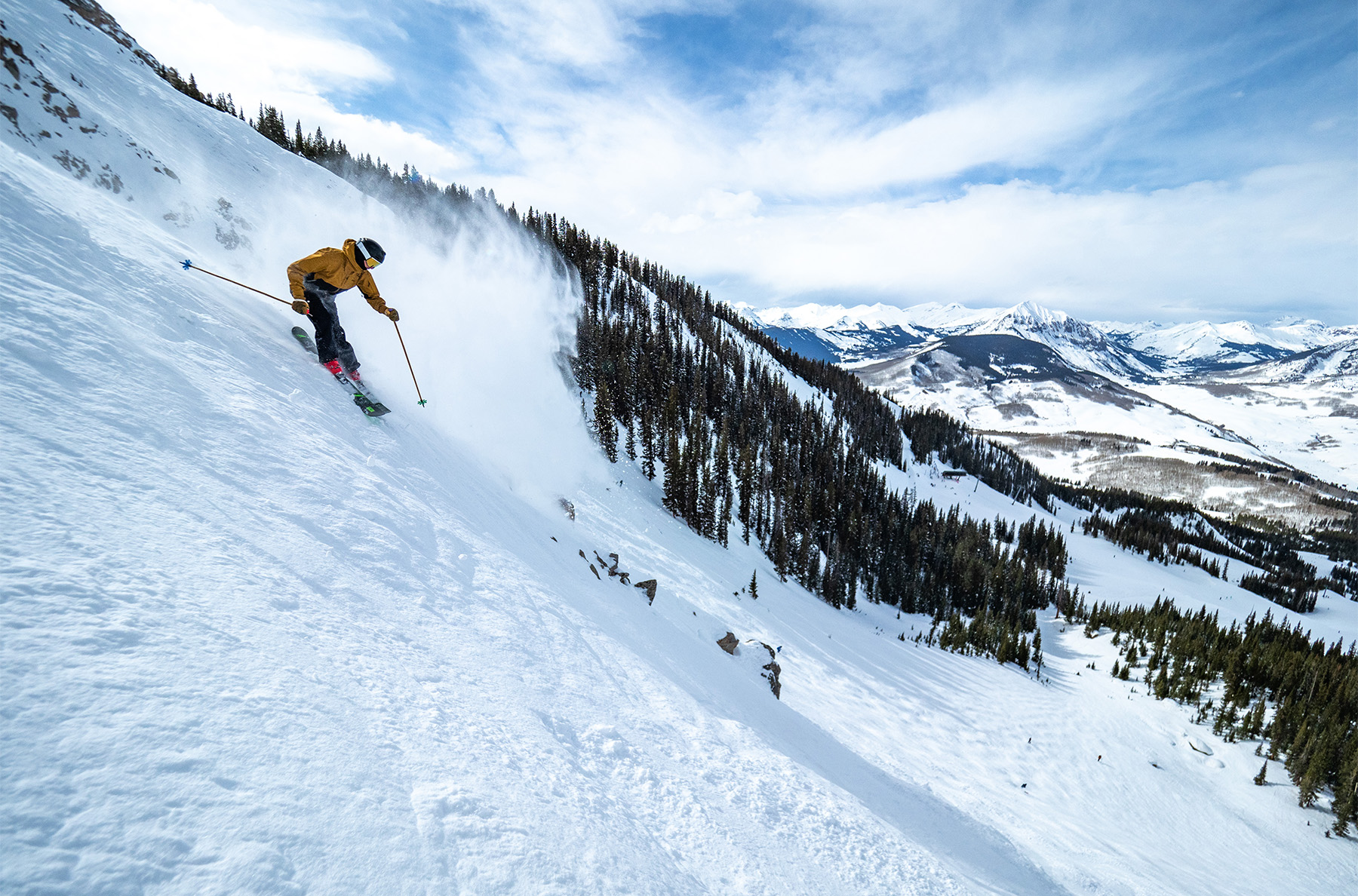Ski: 2023-2024 Line Bacon 108, 184 cm
Test Location: Crested Butte Mountain Resort, CO
Days Skied: ~12
Available Lengths: 166, 172, 178, 184, 190 cm
Blister’s Measured Tip-to-Tail Length (straight-tape pull): 184 cm
Stated Weight per Ski: 2180 grams
Blister’s Measured Weight per Ski: 2194 & 2208 grams
Stated Dimensions: 142-108-137 mm
Blister’s Measured Dimensions: 141.5-107.5-137 mm
Stated Sidecut Radius (184 cm): 17.4 meters
Measured Tip & Tail Splay (ski decambered): 61 mm / 51 mm
Measured Traditional Camber Underfoot: 6 mm
Core Materials: maple/aspen + fiberglass laminate
Base: sintered 1.7 mm
Factory Recommended Mount Point: -4 cm from center / 88 cm from tail
Boots Used: Lange Shadow 130 LV & Atomic Hawx Ultra 130
Bindings Used: Marker Griffon 13

Intro
The word “Bacon” has adorned the name of at least one Line ski for almost two decades now.
The original Sir Francis Bacon was an evolution of Eric Pollard and Line’s iconic Elizabeth ski, and both of those skis played a key role in the backcountry-freestyle revolution of the time, epitomized by Nimbus Independent’s beautiful films.
Since then, the Sir Francis Bacon has undergone numerous changes, and then at the 2023 Blister Summit, Line announced the latest updates — there would be two new skis, simply named the Bacon 108 and Bacon 115, and they featured lots of new construction and design tweaks. Then, midway through the 23/24 season, they announced another ski — the deep-snow specialized of the group, the Bacon 122. All three return for the 24/25 season, just with new graphics.
You can check out our video with Line from that Blister Summit for more of the backstory; ever since we filmed that, we’ve been spending time on the new skis to see what direction Line has gone in with these new all-mountain-freestyle models, and how they slot into the current market.
What Line says about the Bacon 108
“The all-new LINE Bacon 108. Created with all-new Thin Tips, Thick-Cut Sidewalls, and Bio-Resin technologies, the Bacon 108 is a refined and improved iteration of the coveted Sir Francis Bacon. With a versatile 108mm waist width, symmetrical flex, lower swing weight, and durability improvements, the Bacon 108 is your ticket to an all-mountain freestyle ski that can float and butter through powder without sacrificing hard-pack and park performance.”
Construction
As alluded to in Line’s description and expanded upon in our video, above, the Bacon 108 features several new construction elements.
We’ll start with their “Thin Tips,” which, in short, extend the wood core very close to the ends of the ski, and then encapsulate it with a fiberglass-on-fiberglass bond around the very end, with the goal of both reducing swing weight and decreasing the chances of delamination propagation.
In a similar vein, Line aims to optimize the durability of the latest Bacon skis via their “Thick Cut Sidewalls” for improved impact protection, plus their 1.7 mm sintered “Fatty Base” and 2.2×2.5 mm “Fatty Edge.”
At the core, the Bacon 108 and Bacon 115 feature a mix of dense maple wood and lighter aspen, and all those materials are bonded together via their new plant-derived “Bio-Resin,” which reportedly offers better bonding, improved cold-temperature strength, and a 20% reduction in the carbon footprint, relative to their previous, petroleum-based resin.
Shape & Rocker Profile
This is one area that doesn’t seem to have changed a whole lot with the new Bacon 108, relative to the previous-generation (19/20–22/23) Sir Francis Bacon.
The Bacon 108 still features pretty wide, minimally tapered tips and tails, which are paired with moderately deep tip and tail rocker lines. Overall, it’s a pretty symmetrical design that stands out for not being that tapered and, while it features much more tail rocker and tail splay than most directional skis, its rocker profile isn’t that radical for a modern ~108mm-wide freestyle ski.
Flex Pattern
Here’s how we’d characterize the flex pattern of the Bacon 108:
Tips: 5-5.5
Shovels: 6-7
In Front of Toe Piece: 7.5-10
Underfoot: 10
Behind the Heel Piece: 10-8
Tails: 7.5-5
Like many (but not all) previous “Bacon” skis, the Bacon 108 is pretty soft overall. The very ends of its tips and tails are very easy to bend, and then it fairly slowly transitions to the much stiffer cambered section of the ski around the bindings. This is also a very symmetrical-feeling flex pattern, in line with the ski’s pretty symmetrical overall design.
Sidecut Radius
At a stated 17.4 meters for the 184 cm length we’ve been testing, the Bacon 108’s sidecut radius is still a bit tighter than average, but not quite as much of a standout in that regard as the last Sir Francis Bacon (16 m @ 184 cm).
Mount Point (and Length)
True to its freestyle intentions, the Bacon 108 has a pretty centered recommended mount point of about -4 cm from the true center of the ski (when we measure its overall length via our standard straight-tape-pull method).
On that note, it’s probably worth pointing out that, for the Bacon 108 and Bacon 115, Line seems to have based their stated lengths from the skis’ post-pressing lengths, not “material” or pre-pressing lengths. The “184 cm” Bacon 108 actually measures 184 cm long via a straight-tape pull, whereas our previous “184 cm” Sir Francis Bacon measured a bit shorter (182.6 cm) when measured using the same method.
If that’s confusing and/or you want to learn more about the elements that play into how long a given ski feels when you’re skiing it, check out our video and Gear 101 article on How to Think About Ski Length.
Weight
We just talked about several things that seem similar between the Bacon 108 and previous Sir Francis Bacon. This is where that trend ends.
The Bacon 108 is notably heavier than most of the recent SFB’s. At about 2200 grams per ski for the 184 cm length, the Bacon 108 is now on the heavier end of the spectrum for its class, whereas the previous few models were very much on the lighter side of things.
For reference, here are our measured weights for some notable skis. Keep in mind the length differences to try to keep things apples to apples.
1833 & 1894 Head Kore 111, 184 cm
1859 & 1864 Ferreol Surfeur 112, 184 cm
1863 & 1872 Atomic Bent 110, 188 cm
1869 & 1873 Line Sakana, 181 cm
1875 & 1881 Line Sir Francis Bacon, 184 cm (previous version)
1920 & 2006 RMU North Shore 110, 186 cm
1946 & 1962 Black Crows Atris, 184 cm
1947 & 2011 4FRNT Devastator, 186 cm
1951 & 1957 RMU Apostle 106, 184 cm
1956 & 1976 Blizzard Rustler 10, 186 cm
1960 & 1962 Majesty Dirty Bear XL, 186 cm
1970 & 1993 Moment Deathwish 104, 184 cm
2022 & 2029 Icelantic Nomad 106, 188 cm
2049 & 2053 Whitedot Altum 104, 187 cm
2050 & 2084 K2 Mindbender 106C, 183 cm
2060 & 2075 4FRNT Hoji, 184 cm
2073 & 2074 Season Nexus, 183 cm
2072 & 2092 Peak 110 by Bode, 188 cm
2070 & 2103 K2 Reckoner 110, 184 cm
2077 & 2097 Nordica Unleashed 108, 186 cm
2082 & 2089 Blizzard Rustler 11, 186 cm
2078 & 2131 Moment Countach 110, 188 cm
2068 & 2178 Salomon QST 106, 181 cm
2110 & 2117 Fischer Ranger 108, 185 cm
2170 & 2180 Dynastar M-Free 108, 182 cm
2171 & 2191 Wagner Summit 109, 186 cm
2180 & 2195 DPS Koala 111, 184 cm
2182 & 2218 Nordica Enforcer 110 Free, 185 cm
2188 & 2190 Prior Northwest 110, 190 cm
2194 & 2208 Line Bacon 108, 184 cm
2196 & 2211 Rossignol Sender Free 110, 184 cm
2230 & 2290 Line Blade Optic 104, 185 cm
2243 & 2287 Salomon QST Blank, 186 cm
2260 & 2293 Line Bacon 115, 188 cm
2295 & 2344 J Skis Hotshot, 183 cm
2302 & 2342 Dynastar M-Free 108, 192 cm
2318 & 2322 Line Blade Optic 114, 186 cm
2328 & 2370 Rossignol Sender Free 110, 191 cm
2534 & 2543 Heritage Lab FR110, 193 cm
Now, let’s get into on-snow performance:
FULL REVIEW
Luke Koppa (5’8”, 155 lbs / 173 cm, 70 kg): Starting back at Blister Summit 2023 and continuing through the 23/24 season, both Dylan Wood and I have been logging many laps on the 184 cm Bacon 108. Given all the updates Line made, we were curious to see how it compared to the previous SFB (a ski I personally loved), and where it would slot into the latest crop of all-mountain-freestyle skis. Here’s what we’ve found:
Untracked Powder & Soft Chop
Luke: At 108 mm underfoot, the Bacon 108 could be the widest ski in many folks’ quivers, though, within Line’s collection or even just the broader Bacon series (which includes the Bacon 115 & Bacon 122), it’s far from their most powder-specific ski. That’s evident on snow.
In untracked powder, the Bacon 108 requires a pretty centered (or backseat if it’s deep) stance to keep it floating and feeling maneuverable. Driving its shovels in deeper snow can quickly cause them to dive, but, fortunately, this is a ski that’s very intuitive to ski from the centered stance that it prefers. I.e., it’s not a ski that requires you to ski it in a way that goes against the rest of its design, as is sometimes the case with directional skis that make you ski them centered or backseat to prevent tip dive.
In soft snow, the Bacon 108 does feel nicely surfy and maneuverable. It’s not really a standout in the freestyle-oriented class in that regard, and it’s not as loose as the previous SFB and its convex-shaped tips and tails. But the Bacon 108 does feel distinctly looser and easier to pivot when the snow is soft, relative to how it feels when things are firm, which is a great thing in my book. And compared to most directional skis around the same width, the Bacon 108 is very easy to release, pivot, and throw sideways in soft conditions.
When the fresh snow gets cut up, the Bacon 108 can be skied fairly hard for what it is — a pretty soft ski with a centered mount point. It easily bests the previous SFB in terms of composure in chop, since that older ski very easily got knocked around in variable snow.
However, the Bacon 108 still isn’t a very stable ski in the grand scheme, especially if you’re someone who’s paying attention to both the freestyle-oriented and more directional categories. Because of its softer flex pattern and centered mount point, you can’t just drive the Bacon 108’s shovels straight through piles of denser chop (despite its fairly heavy weight). If you do try to do so, you can experience similar tip dive and lack of support from the front of the ski as you can if you try to get way over the shovels in very deep, untracked snow. And if you get knocked backseat by a clump of snow, don’t expect the Bacon 108’s soft tails to be super supportive and quickly push you back over the front of the ski.
Rather, the Bacon 108 encourages a balanced, centered approach to chop (and most conditions, really). If you follow its instructions, this ski doesn’t get deflected super easily by patches of chop at moderate speeds, though it doesn’t love big turns in these conditions — tighter carves, frequent slashes, and tons of airs are what this ski wants in soft, cut-up powder.
Overall, the Bacon 108 feels most at home in soft snow, where you can utilize its engaging shape and flex pattern to make the most of the turns that are available. But if you try to take shortcuts and just bomb straight down the hill, it will quickly let you know that you’re on the wrong ski.
Moguls, Trees, & Tight Terrain
Luke: As we just touched on, the Bacon 108 feels quite maneuverable in soft snow, so if you’re skiing tight, off-piste terrain with a soft surface, that description carries forward to this section. Both tight carves and quick slashes are easy on this ski in most scenarios.
The Bacon 108 does have a significantly higher swing weight than the previous SFB, but because of its fairly centered mount point and symmetrical design, the Bacon 108’s swing weight doesn’t feel nearly as heavy as most directional, more rearward-mounted skis that have similar on-paper weights. I.e., I wouldn’t call the Bacon 108 a very nimble / quick ski, but I also wouldn’t say it comes across as particularly sluggish (especially as someone who skis a huge variety of skis, from ultra-directional to very playful).
The main scenario where the Bacon 108 starts to feel less easy is when you’re skiing very tight moguls that are also pretty firm. In that case, its tips and tails feel notably more inclined to hook up and dig into the snow than they do when the surface is soft. Crested Butte Mountain Resort happens to have plenty of these sorts of moguls on offer throughout the season, and there have been many times when we’ve felt the Bacon 108’s big, wide tails dig into the side of a firm, big mogul more than we’d like.
Fortunately, the ski’s soft flex pattern typically makes it easy to recover from these instances; it’s far from the same sensation as being on a directional carving ski with a stiff, cambered, not-tapered tail that punishes you the moment that tail digs into the snow. Still, this aspect of the Bacon 108 is noteworthy, especially compared to most freestyle-oriented skis with more tapered and/or more rockered tails.
Also, particularly if you aren’t all that used to skiing softer skis with centered mount points, you might run into a different problem — not having enough support from the Bacon 108’s tails. If you typically ski directional skis with more rearward mount points and flatter, stiffer tails, you’ll likely feel that the Bacon 108’s longer (due to its centered mount point), wider (more symmetrical shape), and softer tails are more prone to getting hung up in big, firm bumps, but then it won’t offer lots of support / pushback if you expect it to push you forward and out of the backseat.
All that is to say: the Bacon 108 is a freestyle-oriented ski that isn’t super loose / surfy when the snow is firm, and its freestyle-oriented design will make it feel most intuitive to those who are coming from other skis that share similar intentions and designs.
Firm Chop & Crud
Luke: Assuming that you didn’t skim past the Powder & Soft Chop section, you probably know what’s coming in this one. The Bacon 108 is not a very stable ski in firm, rough, inconsistent snow.
That said, this ski does offer pretty nice suspension. Because it’s fairly heavy for its size and not all that stiff, the Bacon 108 does a good job of muting out / absorbing the vibrations and impacts that typically come with skiing cruddy conditions.
On the other hand, this ski still features several design traits that can often hamper high-speed composure in rough snow. Namely, its softer flex pattern, fairly tight sidecut radius, and centered mount point.
Same as in softer chop, the Bacon 108 is pretty prone to getting knocked around in firmer crud, especially when trying to make bigger, faster turns.
Now, one of the most common misconceptions I hear when it comes to the factors that make a ski feel stable is regarding stiffness. In some circles, it seems that saying a ski is “stiff” is exactly the same as saying it’s “stable” or “composed at high speeds.” But, as we’ve noted countless times over the years, a ski’s flex pattern is just one part of a much larger “stability equation.” For starters, weight is often a huge aspect of that bigger picture, among many other things.
However, the Bacon 108 is a case where its flex pattern feels like a major reason why it doesn’t feel as calm and predictable when skiing faster in more challenging snow, relative to skis that otherwise seem pretty similar on paper. The Bacon 108 just doesn’t offer that much support through the front or back of the ski when you subject it to serious forces / impacts, and then that compounds the ski’s tighter sidecut radius, forcing it to make tighter turn shapes as it bends.
So, the Bacon 108 is notably more damp and planted than the far lighter and even softer-feeling previous SFB. But the Bacon 108 still occupies a somewhat similar slot in the market, in that it’s a ski that wants you to dial things back, take it easier, and find slower, smoother lines when the conditions are rough.
Groomers / On Piste
Luke: For what it is, I think the Bacon 108 is an excellent carver. Don’t expect its on-piste personality to be the same as a very directional ski of the same width, but I’ve had a blast arcing turns on the Bacon 108.
Despite our notes above about its general preference for a centered stance, you can drive the Bacon 108 on firm, smooth snow. And when you do, you’ll be able to turn its softer flex pattern and tighter sidecut radius into fun, via snappy, high-edge-angle carves.
This 108mm-wide ski obviously isn’t super quick edge-to-edge, but it keeps groomers plenty enjoyable most of the time and that’s always a priority for me, even on wider, freestyle-oriented setups.
The main area where the Bacon 108 is less fun on piste is when you hit really firm, scraped-off sections. I’ve still been able to properly carve this ski in those scenarios (no small feat for what it is), but it’s less predictable than most ~108mm-wide directional skis since the more center-mounted, more rockered Bacon 108 has a smaller sweet spot where you can bend its front half and dig in the edges without over-flexing it and causing its tails to release.
Still, for a 108mm-wide, freestyle-oriented ski that’s as maneuverable as the Bacon 108 is in soft snow, it’s tons of fun on most groomers.
Playfulness & Freestyle Performance
Luke: We’ve talked a lot about the Bacon 108 being a freestyle-oriented ski, so how does it actually handle a freestyle-oriented approach to the mountain?
Our answer would be: quite well in some regards, less so in others.
First, the good: the Bacon 108 feels very balanced (in the air and on the snow), it skis switch really well, it’s easy to bend, and it’s pretty surfy in soft snow. On the other hand, the Bacon 108 does not feel all that agile from a swing-weight perspective and, while you can easily get rebound out of it at moderate speeds / with less forceful inputs, its soft flex pattern doesn’t seem to produce the explosive pop that stiffer skis can, once you finally put in the work to bend them.
So, the Bacon 108 wouldn’t be my top pick if you know you want a low swing weight, the absolute loosest ski, or the most energetic one when you’re really pushing it (it’s already less ideal for that last approach, for all the reasons we noted above).
But the Bacon 108 does feel like a very freestyle-friendly ski. I don’t think it’d be a huge stretch to liken it to a big, fairly hefty, slightly more rockered park ski. If you do plan on frequently lapping the park and want something a bit more agile, it also might be worth considering the Line Chronic 101, which shares a strong resemblance to the Bacon 108.
Oh, and if you’re a directional skier who’s curious about whether the Bacon 108 would work better for you if you mounted it a centimeter or two behind its recommended mount point (-4 cm), I wouldn’t focus too much on that. We think this ski performs best with the bindings where Line says they should be, and if you go farther back, you will get even less support from its already pretty soft tails.

Who’s It For?
In general, the Bacon 108 will be best suited for folks with a freestyle background — or who are looking to add a freestyle-focused ski to their quiver. More specifically, it stands out within the wider all-mountain-freestyle category as a softer, less stable option that offers a fairly damp ride quality and a more traditional shape that makes it a lot of fun on piste.
What all of that means is that, for folks in the market for a freestyle-friendly ski, the Bacon 108 won’t be the best choice if you want something particularly nimble, super surfy, or very stable when making bigger turns in challenging snow.
But if you like a pretty symmetrical ski that’s easy to bend without tons of effort / speed, but you don’t like light skis that feel harsh and chattery on firmer snow, the Bacon 108 could be worth a look. Bonus points if you prefer a ski that carves well over one that’s really easy to slash and pivot in hardpacked bumps.
Bottom Line
The latest Line Bacon 108 shares several things in common with its cured-meat-named predecessors, but adds a few twists of its own.
It’s definitely not as ultra-playful and nimble as the ski it replaces, but the new Bacon 108 trades agility and some maneuverability for a bit more capability in rougher snow, all while maintaining a distinctly accessible ride that encourages you to make the most of the terrain and features around you, especially at more moderate speeds and in more consistent conditions.
Deep Dive Comparisons
BLISTER+ members and those who purchase our Digital Access Pass can check out our Deep Dive comparisons linked below. Get our Digital Access Pass to view all our Deep Dives and Flash Reviews, or become a BLISTER+ member today to get access to that and a LOT more, including the best worldwide Outdoor Injury Insurance, exclusive deals and discounts on skis, personalized gear recommendations from us, and much more.
Check out our Deep Dive comparisons of the Bacon 108 to see how it compares to the previous-generation Line Sir Francis Bacon, Line Bacon 115, Line Chronic 101, Season Nexus, Armada ARV 106, 4FRNT Devastator, Nordica Unleashed 108, Dynastar M-Free 108, Majesty Dirty Bear XL, Moment Deathwish 104, Moment Wildcat 108, Whitedot Altum 104, RMU North Shore 110, Atomic Bent 110, Prior Northwest 110, Rossignol Sender Free 110, K2 Reckoner 112, Faction Mana 3, Zag Slap 104, Line Blade Optic 104, & Black Crows Atris.






Looks like rocker pics are from a different ski :)
I don’t know if I would agree with most of your review, you seam to like to compare it to more directional skis and how it fails, but you and I both know that has never been its design, it’s a playful soft ski with some guts to it, to ski all over the mountain for those who come from a park or freestyle attitude, no directional skier in their right mind would ever consider the Bacon as there all mountain ski. To me it’s very reminiscent of the last great Bacon ski, the 2012-2013 year